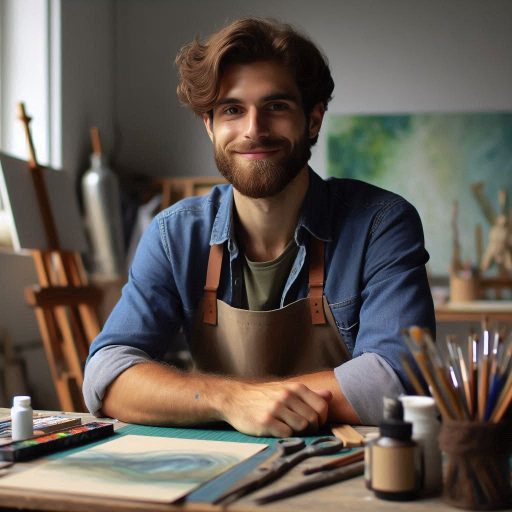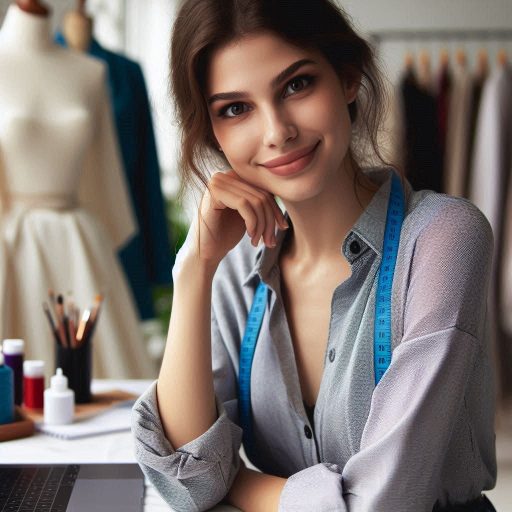Introduction
Creative collaboration between costume designers and directors is essential in bringing a production to life.
Costume design plays a crucial role in setting the tone, time period, and personality of characters in theater and film.
Collaboration ensures that the director’s vision is translated accurately through the costumes, enhancing the overall storytelling.
The costume designer is responsible for researching, designing, and creating costumes that align with the director’s vision and character development.
Understanding the director’s vision
Collaborating with a director starts with understanding their vision for the overall look and feel of the production.
Communication is key in this process, as the director will likely have specific ideas and concepts they want to convey through the costumes.
By understanding and fully grasping the director’s vision, the costume designer can create costumes that not only enhance the story but also align with the director’s creative vision.
Importance of communication in the collaboration process
Open and clear communication between the costume designer and the director is essential for a successful collaboration.
Regular meetings and discussions can help ensure that both parties are on the same page and working towards a shared goal.
Communicating effectively can prevent misunderstandings and conflicts, and ultimately lead to a cohesive and harmonious final product.
How to interpret and translate the director’s vision into costumes
One way to interpret the director’s vision is to analyze the characters, setting, and themes of the production.
Researching different time periods, cultures, and styles can also help in translating the director’s vision into tangible costume designs.
Collaborating with the director in creating mood boards, sketches, and fabric swatches can further refine the costume designs and bring the vision to life.
Examples of successful collaborations between costume designers and directors
The collaboration between Colleen Atwood and Tim Burton in films such as “Alice in Wonderland” and “Edward Scissorhands” showcases a successful pairing of unique visions.
Sandy Powell’s work with Todd Haynes in “Carol” demonstrates a seamless integration of costumes that elevate the storytelling.
Ruth Carter’s collaboration with Ryan Coogler in “Black Panther” resulted in iconic costumes that not only reflected the characters but also celebrated African culture.
In essence, collaborating with directors as a costume designer requires a deep understanding of their vision, effective communication, interpretation skills, and the ability to translate ideas into tangible designs.
When these elements come together, it can result in impactful and memorable costumes that enhance the overall production.
Read: Latest Technologies in Costume Design
Research and Preparation
Before diving into costume design, it is crucial to conduct thorough research to understand the requirements of the production.
Transform Your Career Today
Unlock a personalized career strategy that drives real results. Get tailored advice and a roadmap designed just for you.
Start NowResearch may involve studying the script, historical context, cultural references, and character background to inform design decisions.
Preparation also includes meeting with the director to understand their vision and concept for the costumes within the production.
Once research is complete, the designer can begin gathering inspiration and ideas for the costumes.
Process of Gathering Inspiration and Ideas for Costumes
One of the initial steps in the design process is creating mood boards or collages to visually represent the aesthetic direction.
Costume designers draw inspiration from various sources such as fashion magazines, historical photographs, and art pieces.
Exploring different textures, colors, fabrics, and silhouettes helps in developing unique and cohesive costume designs.
Continuous brainstorming and sketching contribute to refining the vision and translating it into tangible costume concepts.
Importance of Historical and Cultural Accuracy in Costume Design
Costume design plays a crucial role in establishing the time period and setting of the production.
A keen understanding of historical and cultural accuracy ensures authenticity and enhances the audience’s immersion in the narrative.
Details such as fabric choice, accessories, and style reflect the social norms and values of a particular era or culture.
Inaccurate costume design can distract viewers and undermine the overall storytelling of the production.
Collaboration with Other Members of the Production Team
Costume designers collaborate with set designers to ensure harmony between costumes and the overall visual aesthetics of the production.
Communication with lighting designers is essential to consider how costumes will be lit on stage and maintain consistency in the design.
Collaboration fosters a cohesive creative vision across all production elements and ensures a seamless and immersive theatrical experience.
Working closely with directors, costume designers contribute to bringing characters to life and enhancing the storytelling through nuanced costume choices.
Read: Educational Requirements for Art Instructors
Budgeting and Resource Management
When collaborating with directors on costume design, budgeting plays a crucial role in the entire process.
Understanding the allocated funds and managing resources effectively are key to a successful collaboration.
Importance of Budgeting
Budgeting ensures that you stay within the financial limits set by the production.
It helps in making informed decisions when sourcing costumes and materials, ensuring the project stays on track.
Transform Your Career Today
Unlock a personalized career strategy that drives real results. Get tailored advice and a roadmap designed just for you.
Start NowResource Management
It involves effectively utilizing available resources to achieve the desired costume design within the budget.
Properly managing resources ensures that each aspect of costume design is addressed without overspending.
Working Within the Constraints of a Budget
Setting Priorities
When working within a budget, it is essential to set priorities and allocate funds accordingly.
Identify key costumes or scenes that require more investment and adjust other areas to accommodate budget constraints.
Costume Rental and Reuse
Opting for costume rental or reusing existing costumes can help in cost-saving.
This approach allows you to acquire high-quality costumes at a fraction of the cost of creating new ones.
Sourcing and Acquiring Costumes and Materials
Research and Planning
Researching and planning are essential when sourcing costumes and materials within a budget.
Look for affordable options without compromising the quality of the costumes required for the production.
Collaboration with Suppliers
Establishing good relationships with costume suppliers can help in getting discounts or special deals.
Collaborate with suppliers to find cost-effective solutions that meet the creative vision of the director.
Creative Problem-Solving When Resources Are Limited
Adaptation and Alteration
In situations where resources are limited, consider adapting or altering existing costumes to fit the production’s requirements.
This creative approach can help in achieving the desired look without exceeding the budget.
DIY and Upcycling
DIY projects and upcycling can be great alternatives when facing resource constraints.
Repurposing materials or creating costumes from scratch can add a unique touch to the production.
Read: Costume Design for Theater vs. Film

Fittings and revisions
Importance of costume fittings with actors
Costume fittings with actors are crucial as they allow the costume designer to ensure that the costumes fit and flatter the actors’ bodies.
This personal interaction also helps build rapport and trust between the designer and the actor.
Actors may provide valuable feedback during fittings, leading to adjustments and revisions that enhance the overall look and feel of the costumes.
Costume fittings help the actors get comfortable with their costumes, allowing them to move freely and perform confidently on stage or screen.
Revisions may be necessary to address any issues that arise during rehearsals or filming, ensuring that the costumes continue to meet the director’s vision.
Transform Your Career Today
Unlock a personalized career strategy that drives real results. Get tailored advice and a roadmap designed just for you.
Start NowCollaborating on adjustments and alterations to costumes
Collaborating on adjustments and alterations to costumes is a collaborative process that requires open communication and flexibility from both the costume designer and the director.
Costume designers must be willing to make changes based on feedback from the director, actors, and other members of the production team.
This willingness to adapt and evolve the costumes throughout the rehearsal process can lead to a more polished and cohesive final product.
Flexible and open-minded approach to changes during the rehearsal process
Flexibility is key when working on adjustments and alterations to costumes, as changes may need to be made quickly and efficiently to meet production deadlines.
Keeping an open mind and being willing to explore different options can lead to unexpected discoveries and creative breakthroughs.
Costume designers and directors must work together to balance creativity and practicality, ensuring that the costumes not only look good but also serve the needs of the production.
By collaborating on adjustments and alterations to costumes, costume designers and directors can create a harmonious and visually stunning final result that enhances the overall performance.
Read: Budgeting for a Costume Design Project
Continuing Collaboration During Production
During the production phase, costume designers work closely with directors to bring the vision to life.
They collaborate on crucial decisions such as color schemes, fabrics, and overall aesthetic.
Constant communication is key to ensuring that the costumes enhance the storytelling and character development.
Adjustments may be required as the production progresses, and the costume designer must be flexible.
Providing Ongoing Support and Adjustments During Performances
Costume designers play a vital role in maintaining the integrity of the costumes throughout performances.
They are responsible for any last-minute alterations or repairs needed to ensure the costumes look flawless on stage.
Costume designers must be present during dress rehearsals and performances to address any issues that arise.
Their ongoing support helps the cast feel confident and comfortable in their costumes, enhancing their performances.
Communication with Actors and Crew Members Regarding Costume Needs
Costume designers must communicate effectively with actors to understand their character and costume requirements.
They collaborate with wardrobe teams to ensure that costumes are properly fitted and maintained.
Open communication with crew members helps streamline the costume design process and resolve any challenges.
Costume designers act as a liaison between the director’s vision and the practical needs of the cast and crew.
Transform Your Career Today
Unlock a personalized career strategy that drives real results. Get tailored advice and a roadmap designed just for you.
Start NowEnsuring That Costumes Align with the Overall Vision of the Production
Costume designers must ensure that every costume choice aligns with the overall mood and theme of the production.
They work closely with the director to create a cohesive look that enhances the storytelling.
Attention to detail is crucial in ensuring that costumes reflect the time period and setting of the production.
Costume designers must balance creative freedom with adherence to the director’s vision to create a harmonious final product.
In a nutshell, collaboration between costume designers and directors is essential to the success of any production.
By maintaining open communication, providing ongoing support, and aligning costumes with the overall vision, they can create memorable and impactful performances.
Explore Further: Iconic Furniture Designs and Their Designers
You Might Also Like: The Role of Market Research in Advertising Design
You Might Also Like: Best Software for Fashion Design Projects
Conclusion
Collaboration between costume designers and directors is crucial for a successful production.
By working together, they can bring the vision of the show to life effectively.
The role of costume design goes beyond just clothing; it helps define characters and enhance storytelling.
This process of collaboration not only impacts the final product but also enriches the overall experience.
In addition, the partnership between costume designers and directors plays a significant role in the success of a production.
[E-Books for Sale]
The Big Book of 500 High-Paying Jobs in America: Unlock Your Earning Potential
$19.99 • 500 High-Paying Jobs • 330 pages
Explore 500 high-paying jobs in America and learn how to boost your career, earn more, and achieve success!
See All 500 High-Paying Jobs of this E-Book
1001 Professions Without a Degree: High-Paying American Jobs You Can Start Now
$19.99 • 1001 Professions Without a Degree • 174 pages
Discover 1001 high-paying jobs without a degree! Unlock career tips, skills, and success strategies for just $19.99!




